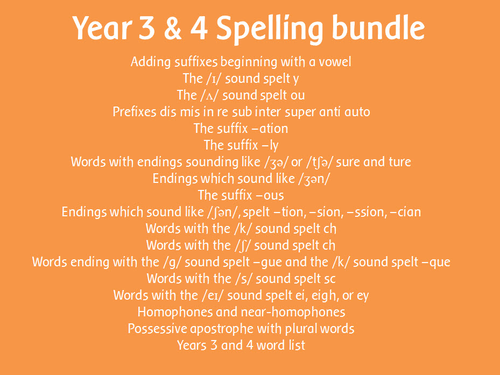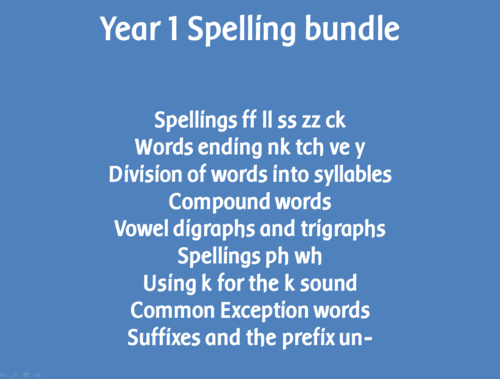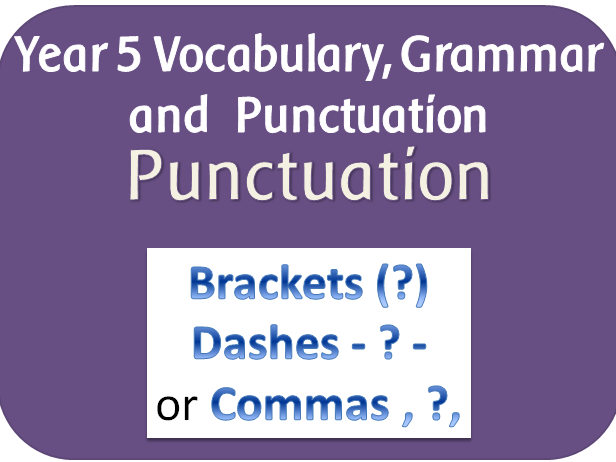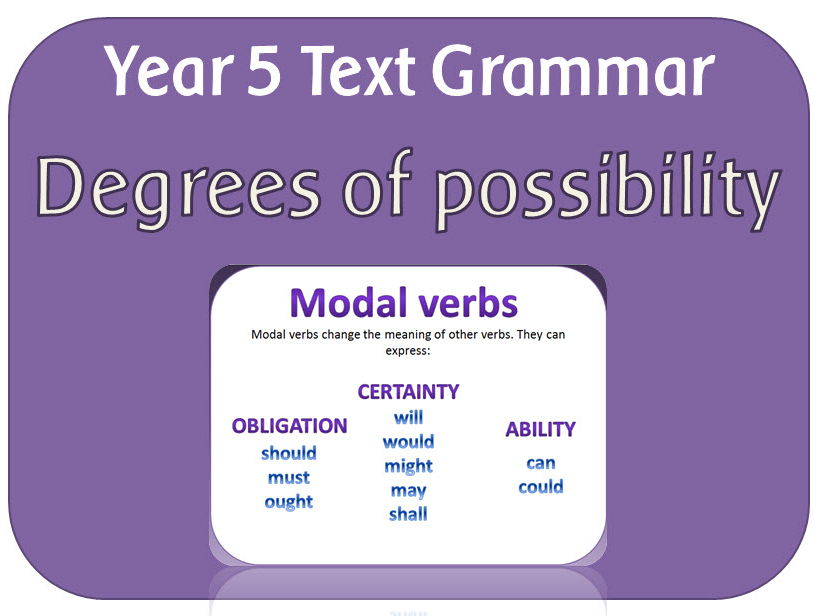
404Uploads
1066k+Views
681k+Downloads
World languages

Grapheme pack: ee words
This pack contains 7 resources: A PowerPoint lesson for children to write words containing the new grapheme, 4 differentiated worksheets, picture and word cards and a large flashcard.
The font used is Sassoon with an additional copy in Elementary font.

Grapheme pack: ar words
This pack contains 7 resources: A PowerPoint lesson for children to write words containing the new grapheme, 4 differentiated worksheets, picture and word cards and a large flashcard.

Grapheme pack: ai words
This pack contains 7 resources: A PowerPoint lesson for children to write words containing the new grapheme, 4 differentiated worksheets, picture and word cards and a large flashcard. The font is Sassoon infant, with an additional pack in Elementary / Primer print.

Year 2 Spelling SPag Adding ing, ed, er and est to a root word ending in a consonant then y
This set of 8 resources is to help children learn the rules for adding suffixes.
It contains the following files:
Adding suffixes to words ending in y: Explains what a root word and a suffix is, and shows the addition of -ed and -ing, pointing out the differences.
Quick write - Adding ed to verbs ending in y
Quick write - Adding ing to verbs ending in y
Quick write - Adding er to words ending in y
Quick write - Adding est to words ending in y
(Quick write activities show firstly the root word, then how it changes/stays the same when the suffixes are added.)
ACTIVITIES
Words ending in a consonant then y matrix: to fill in
TEACHER RESOURCES
Y2 Spelling Appendix: Adding suffixes to words ending in y- An adaptable outline plan
Word List - With relevant words ending in y.

Y6 SPaG Punctuation resources: Colon, semi-colon, dash, bullet points and hypens
This set includes 2 resources:
One powerpoint explaining:
the use of the semi-colon, colon and dash to mark the boundary between independent clauses
use of the colon to introduce a list and use of semi-colons within lists
punctuation of bullet points to list information
Plus 5 A4 posters explaining the use of the colon, semi-colon, dashes, bullet points and hypens
Bundle

Year 3 & 4 SPaG: Spelling bumper pack
This pack contains resources to teach all the objectives in the Year 3 and 4 Spelling appendix. It includes powerpoint lessons, worksheets, activities and outline plans.
Bundle

Year 1 SPaG: Spelling bumper pack
This pack contains resources to teach all the objectives in the Year 1 Spelling appendix. It includes powerpoint lessons, worksheets, activities and outline plans.

Parts of Speech Posters; SPaG, Grammar display
A set of 9 A4 posters plus A4 title and large banner.
The posters describe, name and give examples of each word class.
The posters cover the main 8 parts of speech, plus ‘determiners’ which is often included as the ninth part of speech.
The titles of the posters are:
Adjective
Adverb
Conjunction
Interjection
Noun
Preposition
Pronoun
Verb
Determiner
There are also blank versions to laminate and use for word walls, vocabulary collections etc.

Vocabulary, grammar and punctuation school assessment Years 1 - 6
A set of materials to assess Appendix 2 for Years 1 to 6 in the English curriculum 2014. It contains a booklet for individual assessment and also class recording sheets.

SPaG Year 6 Terminology powerpoint
A powerpoint explaining the terminology for pupils in Y6: subject, object, active, passive, synonym, antonym
ellipsis, hyphen, colon, semi-colon and bullet points.

SPaG Year 6 Text Grammar: Linking ideas using cohesive devices
A powepoint and display file to help children remember a range of cohesive devices in their writing.
POWERPOINT:
Cohesive devises: Looks at and explains cohesive devices such as synonyms; pronouns; verb tenses; repetition of a phrase; adverbials and ellipses
PRINTABLE FILE (PDF):
Cohesive devices display: For reference - it contains all the terminology above.

SPaG Year 6 Sentence Grammar: Informal and formal writing powerpoint
The powerpoint explains how to change writing styles/register according to audience, purpose and text, and what tone to use for each. Shows examples of similar sentence written in a formal and an informal style. Ends with an activity where the children have to turn an informal sentence into a formal one.

SPaG Year 6 Sentence Grammar: Use of the passive
POWERPOINT: Explanation of active and passive sentences and how to arrange an active sentence to make it passive. Explains how and when passive sentences can be used
PRINTABLE FILES (PDF): Passive sentences worksheet: Change the active sentences into passive sentences

SPaG Year 6 Word Grammar: How words are related by meaning as synonyms and antonyms
POWERPOINTS:
The history of the English language: A history, plus an explanation of why the English language has so many synonyms.
Synonyms: Explains what they are and gives 11 words with related synonyms.
Antonyms: Explains what they are and gives 12 words with corresponding antonyms, plus 7 words with several antonyms.
Antonyms and prefixes beginning with 'i': Formation of antonyms by adding im, in or il to words.
Antonyms and prefixes recap: Activity to make words by adding a range of prefixes covered in previous years, to make antonyms.
PRINTABLE FILES (PDF):
Synonyms worksheet: For finding synonyms
Antonyms worksheet: re-write the sentences to make it mean the opposite
House for sale - antonyms worksheet: Rewrite the advert using antonyms
House for sale - synonyms worksheet: Rewrite the advert using synonyms
Antonym cards (2 sets): Matching sets - easy and more difficult

SPaG Year 6 Word Grammar: Formal and informal vocabulary
A powerpoint lesson and worksheet to teach the difference between vocabulary typical of informal speech and vocabulary appropriate for formal speech and writing.

SPaG Year 5 Terminology powerpoint
Explains the terminology specified in Y5: modal verb, relative pronoun, relative clause, parenthesis, cohesion and ambiguity.

SPaG Year 5 Punctuation: Parenthesis (brackets, dashes, commas) and commas to clarify meaning
This pack contains 2 powerpoint lessons:
Parenthesis: How brackets, dashes or commas can be used to indicate parenthesis.
Commas: Gives examples of what can happen if commas are omitted, and how they are important to the intended meaning.

SPaG Year 5 Sentence Grammar: Relative clauses beginning with who, which, etc
A set of Y5 resources to teach about relative clauses beginning with who, which, where, when, whose, that, or an omitted relative pronoun
POWERPOINTS:
Relative clauses - pronouns who which that
Relative clauses with pronoun whose
Relative clauses with when and where
PRINTABLE FILES (PDF):
Relative clauses worksheet who which that
Relative clauses worksheet whose
Relative clauses worksheet when & where

SPaG Year 5 Sentence Grammar: Degrees of possibility using adverbs or modal verbs
A powerpoint teaching about how to indicate degrees of possibility using adverbs or modal verbs might, should, will, must.




















